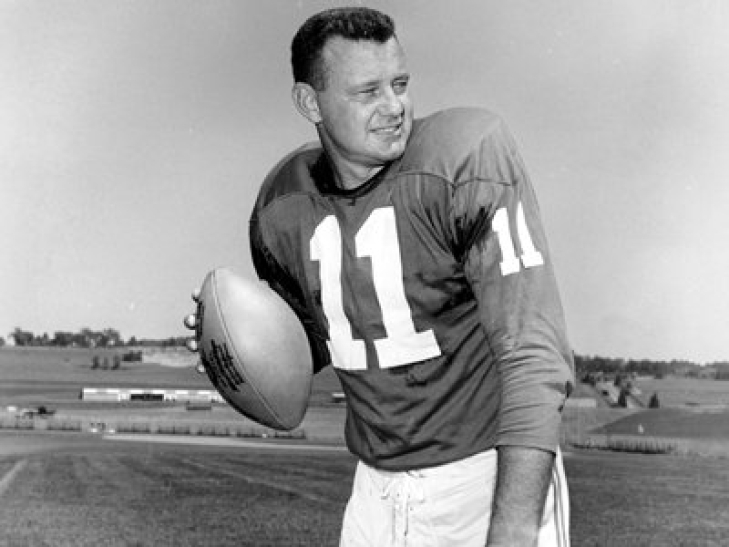
Committee Chairman
Pro Football Hall of Fame Revisited Project: 1966 FINAL VOTE
1966 Pro Football Hall of Fame Revisited Project Class.
Here we are! Again!!
If you have been following our Pro Football Hall of Fame Revisited Project, you know we have asked the rhetorical question: What if the PFHOF began in January 1946?
After soliciting and obtaining a passionate group of football fans and historians, we sent out a ballot for a Preliminary Vote, in which we asked each voter to give us 25 names as their semi-finalists and 5 in the Senior Pool. We then asked the group to vote for their 15 Finalists in the Modern Era and 3 in the Senior Category. The final stage was to vote for their five Modern Era inductee and one Senior inductee.
This is the result of the 21st official class;
Below are the final results of this project based on 3q votes,
Remember that the group took a vote in “1966”, and we have reverted back to the top five candidates entering the Hall PROVIDING THEY MAKE 50% of the vote. This will be put to a vote again in “1969”.
This is for the “Modern Era”
*Bold indicates they have been elected to the Pro Football Hall of Fame Revisited Class of 1966:
|
Player |
Year of Eligibility |
Vote Total |
|
Norm Van Brocklin QB |
1 |
31 |
|
Dick Stanfel G |
3 |
18 |
|
Ed Sprinkle DE-E-G-LB |
6 |
16 |
|
Ward Cuff WB-QB-HB |
14 |
14 |
|
Gene Brito DE-E |
1 |
12 |
|
Whizzer White TB-HB |
20 |
9 |
|
Bobby Dillon S |
2 |
9 |
|
Pat Harder FB |
8 |
8 |
|
Marshall Goldberg FB |
13 |
7 |
|
Bill Osmanski FB |
14 |
6 |
|
Billy Wilson E-FL |
1 |
5 |
|
Buckets Goldenberg G-BB |
16 |
4 |
|
Alan Ameche FB |
1 |
4 |
|
Tank Younger FB-LB-HB |
3 |
1 |
|
Bruno Banduccii G |
7 |
0 |
This is for the “Senior Era”,
*Bold indicates they have been elected to the Pro Football Hall of Fame Revisited Class of 1966, though no candidate made the 50% threshold.
|
George Christensen |
3 |
15 |
|
Hunk Anderson |
16 |
9 |
|
Al Nesser |
9 |
4 |
|
None of the Above |
N/A |
3 |
About the 1966 Inductees:
Norm Van Brocklin QB, RAM 1949-57 & PHI 1958-60: Inducted in the Pro Football Hall of Fame Revisited Project in 1966 on his 1st Ballot. Inducted into the actual Pro Football Hall of Fame in 1971.
Norm Van Brocklin entered the NFL as a Fourth Rounder from Oregon, but the Quarterback entered a unique situation where he shared the duties with fellow Hall of Famer, Bob Waterfield. It worked well enough, as Van Brocklin was an NFL Champion in 1951, and he was still among the league leaders in passing, winning the Passing Yards Title in 1954, after Waterfield’s retirement.
Van Brocklin retired in 1958 but thought better of it, and the Rams traded him to Philadelphia, where he picked up right where he left off. The QB would have a monster 1960 season, winning the UPI MVP, NEA MVP, and Bert Bell Award while leading the Eagles to an NFL Championship. With that win, the “Dutchman” could say he did one thing no other QB could defeat a Vince Lombardi-led team in a Championship Game.
Dick Stanfel G, DET 1952-55 & WAS 1956-58: Inducted in the Pro Football Hall of Fame Revisited Project in 1965 on his 3rd Ballot. Inducted into the actual Pro Football Hall of Fame in 2016.
From the University of San Francisco, Dick Stanfel arrived in Detroit as the Second Overall Pick in 1951, but a knee injury prevented him from joining the Lions until 1952.
He was worth the wait.
The Guard anchored Detroit to NFL Championships in 1952 and 1953, and the five-time First Team All-Pro was traded to Washington, where he was a stalwart on their line before retiring early to join Notre Dame on their coaching staff. He was named to the 1950s All-Decade Team.
Ed Sprinkle, DE-E-G-LB, CHI 1944-55. Inducted in the Pro Football Hall of Fame Revisited Project in 1966 on his 6th Ballot. Inducted into the actual Pro Football Hall of Fame in 2020.
Joining the Chicago Bears in 1944 after being undrafted out of Navy, Sprinkle would help the Bears win the 1946 NFL Championship. Sprinkle would become a significant player on the defensive side of the ball, where he would become known as a ferocious (some would say dirty) pass rusher and was a forebearer for what would come. Think about that for a second. In a sport where you are encouraged to do whatever it takes, he was feared among players in a game who aren't afraid of much.
Regardless of that assessment, this was a highly skilled football player. Sprinkle would be named to four Pro Bowls in the '50s, and he would be named to the 1940's All-Decade Team.
Our All Time Top 50 Florida Panthers have been revised to reflect the 2023-24 Season
Yes, we know that this is taking a while!
As many of you know, we at Notinhalloffame.com are slowly generating the top 50 of each major North American sports team. That being said, we have existing Top 50 lists and consistently look to update them when necessary and based on necessity. As such, we are delighted to present our post-2023-24 revision of our top 50 Florida Panthers.
As for all of our top 50 players in hockey, we look at the following:
1. Advanced Statistics.
2. Traditional statistics and how they finished in the National Hockey League.
3. Playoff accomplishments.
4. Their overall impact on the team and other intangibles that are not reflected in a stat sheet.
Last year, Florida finally did it! They won their first Stanley Cup championship with a deep and talented squad. As this franchise formed in the 1990s, last season’s accomplishments led to one of the most significant changes ever in our 50 franchise lists.
As always, we present our top five, which saw some significant changes:
1. Roberto Luongo
2. Alexsander Barkov
3. Jonathan Huberdeau
4. Aaron Ekblad
5. John Vanbiesboruck
You can find the entire list here.
Again, as this is still a young franchise, the changes were huge.
It was very tempting to put Barkov at #1, and perhaps it is a mistake not to have done so. Barkov captained the Panthers to their first Stanley Cup, but Luongo was a first ballot Hall of Famer. An average Barkov season will easily place Barkov at #1.
Aaron Ekblad, who was #5, moved up one spot to #4.
Goalie Sergei Bobrovsky, who was third in Vezina Trophy voting, rocketed to #10 from #19.
We might have made a mistake in not ranking Sam Reinhart last year. That has been corrected, and the sniper who lit the lamp 57 times last year is here at #18.
Defenseman Dmitry Kulikov, who began his second run in Florida last season, climbed to #21 from #26.
2022/2023 Second Team All-Star Matthew Tkachuk rocketed to #25 from #42.
Defenseman Gustav Forsling reached #26 from #35.
Center Carter Verhaeghe went to #28 from #34.
Defenseman Brandon Montour, who is now with Seattle, advanced from #36 to #30.
Center Sam Bennett jumped ten spots to #39.
We thank you for your continued support of our lists on Notinhalloffame.com.
National Casino: Patriotic Gambling Venues Around the World
A journey into the realm of national casinos, where to gamble means to be patriotic. Learn about their characteristics, the most popular destinations, and their impact on the economy.
National Casinos: Gaming with a Patriotic Twist
National casinos mix the euphoria of gaming with a very lively identity of the nation. State-driven gaming establishments take up new twists that are based on culture and heritage in most host countries. Let’s delve into the world of national casino and explore what makes them stand out from an ever-growing gambling industry.
What Makes National Casinos Unique?
Some features make national casinos stand out, quite clearly apart from their privately-owned brothers:
- Owned and managed by a government; incorporation of local culture and traditions into them;
- Tighter regulations and controls;
- Development of local tourism and growth of the economy; specialty games reflecting national sports.
It is from these aspects that an atmosphere is built to which both domestic and international visitors are attracted, as they seek a genuinely indigenous gambling experience.
The Economic Effect of National Casinos
National casinos could indeed be good providers in terms of rural economic development. Casinos bring in large revenues for governments that are then reinvested into public services and infrastructure. They also provide employment and attract tourists, possibly giving the economy more of a boost.
Indeed, national casino industries have emerged as strong drivers in the economies of many countries. It is an industry that provides a mode of entertainment and, at the same time, improves national coffers by way of taxes and licensing fees.
Popular National Casino Destinations
A handful of nations have embraced the concept of national casinos; each offers something unique from the perspective of a gambling experience:
Monte Carlo Casino, Monaco
Perhaps the most famous national casino globally is the Monte Carlo Casino. It is government-owned in Monaco and has been showcased as a subject in various movies featuring this destination. It attracts high-rollers from around the globe.
Singapore's Marina Bay Sands
Being not fully owned by any government, Marina Bay Sands, however abides by the strict set regulations by the nation, this integrated resort models the commitment of Singapore to the controlled gambling expansion and tourism development.
Canadian Provincial Casinos
The national casino approach in Canada is ownership and operation by the provinces. Each of the various provinces controls its own gaming centers to ensure that proceeds reach the locals directly.
The Future of National Casinos
The casinos have moved with the tide to develop continuously with the latest trends and use of technology. Most of them are now opening an online platform to increase their clientele base but still retain their national identity.
Some of the emerging trends in casinos involve:
- Virtual gambling experience
- Incorporation of cryptocurrency as a mode of payment
- Offering of sports betting increasingly
- More steps taken for responsible gambling
- Partnership with international casino brands
These inventions are targeting to make national casinos globally competitive while at the same time maintaining their uniqueness.
National casinos are, therefore, as appetizing a blend of the rush in gambling as the national spirit. With the expansion in size and structure, it is highly probable that casinos are going to play an increasingly greater part not only in the domain of recreation but also in the national economies worldwide. Whether for a serious gambler or an observer, a national casino is sure to introduce them to an experience quite unlike any other and far removed from the ordinary.
Our All-Time Top 50 Indiana Pacers have been revised to reflect the 2023-24 Season
Yes, we know that this is taking a while!
As many of you know, we at Notinhalloffame.com are slowly generating the top 50 of each major North American sports team. That being said, we have existing Top 50 lists and consistently look to update them when necessary and based on necessity. As such, we are delighted to present our post-2023-24 revision of our top 50 Indiana Pacers.
As for all of our top 50 players in basketball, we look at the following:
1. Advanced Statistics.
2. Traditional statistics and how they finished in the National Basketball Association.
3. Playoff accomplishments.
4. Their overall impact on the team and other intangibles that are not reflected in a stat sheet.
Last year, Indiana continued to improve by making it to the Eastern Championship Finals. There were no new entrants, but three elevations.
As always, we present our top five, which saw no changes:
1. Reggie Miller
2. Mel Daniels
3. George McGinnis
4. Roger Brown
5. Billy Knight
You can find the entire list here.
Veteran Center Myles Turner moved to #12 from #17.
Tyrese Haliburton, who was a Third-Team All-NBA Player last season, vaults to #24 from #47.
T.J. McConnell jumped to #41 from #50.
We thank you for your continued support of our lists on Notinhalloffame.com.





